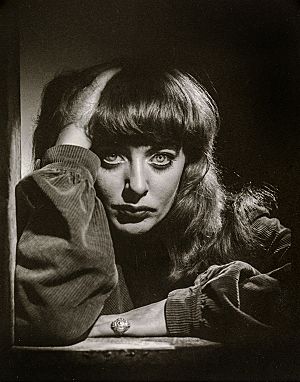Vali Myers facts for kids
Quick facts for kids
Vali Myers
|
|
|---|---|

Vali Myers photographed by Norman Ikin around 1959
|
|
| Born | 2 August 1930 |
| Died | 12 February 2003 (aged 72) Melbourne, Australia
|
| Nationality | Australian |
Vali Myers (born August 2, 1930 – died February 12, 2003) was an Australian artist and dancer. She was known for her unique style and inspired many people. News about her was mostly shared in the 1950s and 1960s in Europe and the United States.
Contents
Early Life and Dance
Vali Myers was born in Canterbury, Sydney, Australia, on August 2, 1930. Her mother was a violinist, and her father worked with marine radios. Vali showed a talent for art from a young age.
In 1941, her family moved to Box Hill, Melbourne. Vali left home when she was 14 years old. She worked in factories to pay for her dance lessons. She became very involved in dance and later became a main dancer for the Melbourne Modern Ballet Company.
In 1949, when she was 19, Vali traveled to Paris, France. Paris was still recovering from World War II. She wanted to continue her dance career there. She found herself living a simple life in the Saint-Germain-des-Prés area. A 1954 photo book called Love on the Left Bank by Ed van der Elsken shows the artistic life in Paris. Vali Myers is a main character in this book, which tells a story inspired by real life. Some of her early drawings are also shown in the book.
Artistic Career
Vali Myers was a very expressive fantasy artist. She created art using pen, ink, and watercolors. She was also a dancer in nightclubs. She spent her life living in different places. These included her home in Melbourne, the Hotel Chelsea in New York City, a old cottage near Positano in Italy, and a home in Paris.
Her artworks changed over time. They started as detailed black and white drawings. Later, she used many bright colors, watercolors, and even gold leaf. Her art showed a very careful way of drawing her own magical world. She knew many famous people, like Tennessee Williams, Salvador Dalí, Django Reinhardt, Jean Cocteau, Patti Smith, and Mick Jagger.
Vali Myers' paintings sold for a lot of money, sometimes up to $40,000 US dollars in New York. Her art is part of important collections, like the Stuyvesant collection in the Netherlands. Many private art collectors also own her work.
Life in Italy
While in Europe, Vali married Rudi Rappold, who was from Vienna, Austria. They moved to Positano, Italy. Their marriage later ended. Vali then lived with Italian artist Gianni Menichetti. Together, they turned her property into a safe place for wild animals. This wildlife sanctuary was supported by the World Wildlife Fund.
In 1993, Vali returned to Melbourne after experiencing some health issues. She opened an art studio in the Nicholas Building. She only visited Positano sometimes after that.
Later Years and Passing
Vali Myers passed away in Melbourne on February 12, 2003. She was 72 years old. She had recently been diagnosed with cancer.
Exhibitions and Films
An exhibition of Vali Myers' artwork was held at LUMA (La Trobe University Museum of Art) in 2013. The show was called Between Dusk and Dawn. It featured many of her works from private collections in the US and Europe. The exhibition ran during September and October.
Several films have been made about Vali Myers' life and art:
- Vali, The Witch of Positano (1965): This film was co-produced by George Plimpton. It won an award at the 1965 Mannheim Film Festival.
- The Invasion of Thunderbolt Pagoda (1968): An experimental film by Ira Cohen.
- Vali: Death in Port Jackson Hotel (1971): A film by Ed van der Elsken. It shows Vali in her special place in Italy where she created her art.
- Patti and Vali (1973): A short film by Sandra Dailey. It shows Patti Smith getting a tattoo from Vali. Patti Smith also talks about Vali in the film.
- Vali: The Tightrope Dancer (1989): A documentary by Australian filmmaker Ruth Cullen.
- Painted Lady (2002): This was Ruth Cullen's second film about Vali. It shows Vali in her studio and with her friends.
Vali Myers' Legacy
Vali Myers greatly inspired the young musician Patti Smith. Patti Smith had many pictures of Vali and her art on her walls. When they met in New York, Vali gave Patti a lightning bolt tattoo on her knee. This moment was captured in a film by Sandra Dailey.
Vali was also the inspiration for a character named Carol in the play Orpheus Descending by Tennessee Williams. She is also mentioned in the 1994 autobiography Faithfull by Marianne Faithfull. The song "Ballerina Valerie" by Joni Mitchell is about Vali.
British singer Florence Welch said that Vali was a big influence for her band, Florence and The Machine's, third album, How Big How Blue How Beautiful. Vali Myers also inspired the painting "Queenie" by Ching Ho Cheng. This painting is now part of the permanent collection at the Cleveland Museum of Art.
Images for kids


